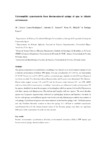Mostrar o rexistro simple do ítem
Extremophilic cyanobacteria from thermo-mineral springs of spas in Atlantic environments
| dc.contributor.author | López-Rodríguez, M. Carmen | |
| dc.contributor.author | Asencio, Antonia D. | |
| dc.contributor.author | Meijide-Faílde, Rosa | |
| dc.contributor.author | Torres, Enrique | |
| dc.date.accessioned | 2022-05-12T07:38:44Z | |
| dc.date.issued | 2022-04-12 | |
| dc.identifier.citation | M. Carmen López-Rodríguez, Antonia D. Asencio, Rosa M. Meijide & Enrique Torres (2022) Extremophilic cyanobacteria from thermo-mineral springs of spas in Atlantic environments, Systematics and Biodiversity, 20:1, 2046198 | es_ES |
| dc.identifier.issn | 1478-0933 | |
| dc.identifier.uri | http://hdl.handle.net/2183/30646 | |
| dc.description.abstract | [Abstract] The species composition of cyanobacteria assemblages was studied in six thermo-mineral springs of spas in Atlantic environments of Galicia (NW Spain). Two are considered hot (Ta ≥ 40 °C), two intermediate (Ta 20–40 °C) and two cold (Ta ≤ 20 °C), and four contain hydrogen sulphide. A total of 21 taxa (14 genera) have been recorded. Two diversity indices, Shannon index and Evenness were determined. The Shannon–Wiener index ranged between 0.31 and 0.73 and the Evenness index between 0.44 and 0.88. nMDS ordination showed that cyanobacteria assemblage composition was influenced mostly by temperature. Of the species identified, the most diverse genus is Leptolyngbya with four species, followed by Chroococcus with three species and Aphanocapsa, Phormidium and Lyngbya with two species. The most abundant species was Jaaginema angustissimum, followed by Leptolyngbya laminosa and Symploca thermalis. In the two cold springs, seven different species were found, and only Aphanocapsa conferta was common to both springs. Cyanobacterial species were more numerous in the four hot springs, with 15 different species and only Calothrix thermalis common to these hot springs. It is difficult to establish characteristic cyanobacterial flora for the thermo-mineral waters of the Galician springs since there are significant differences in the communities from the six sites studied. | es_ES |
| dc.description.sponsorship | Xunta de Galicia; 10 PXIB 310 153 PR | es_ES |
| dc.description.sponsorship | Xunta de Galicia; GRC GI-1809 BIOAPLIC | es_ES |
| dc.description.sponsorship | Xunta de Galicia; ED431C 2019/07 | es_ES |
| dc.description.sponsorship | Xunta de Galicia; ED431E 2018/09 | es_ES |
| dc.language.iso | eng | es_ES |
| dc.publisher | Taylor & Francis | es_ES |
| dc.relation.uri | https://doi.org/10.1080/14772000.2022.2046198 | es_ES |
| dc.rights | This is an Accepted Manuscript of an article published by Taylor & Francis in Systematic and Biodiversity on 2022, available at: http://www.tandfonline.com/10.1080/14772000.2022.2046198 | es_ES |
| dc.subject | Atlantic environments | es_ES |
| dc.subject | Cyanobacteria | es_ES |
| dc.subject | Diversity | es_ES |
| dc.subject | Environmental parameters | es_ES |
| dc.subject | Galicia (NW Spain) | es_ES |
| dc.subject | Spa | es_ES |
| dc.subject | Thermo-mineral springs | es_ES |
| dc.subject | Thermal-sulphur waters | es_ES |
| dc.title | Extremophilic cyanobacteria from thermo-mineral springs of spas in Atlantic environments | es_ES |
| dc.type | info:eu-repo/semantics/article | es_ES |
| dc.rights.access | info:eu-repo/semantics/embargoedAccess | es_ES |
| dc.date.embargoEndDate | 2023-04-12 | es_ES |
| dc.date.embargoLift | 2023-04-12 | |
| UDC.journalTitle | Systematics and Biodiversity | es_ES |
| UDC.volume | 20 | es_ES |
| UDC.issue | 1 | es_ES |
| UDC.startPage | 2046198 | es_ES |
Ficheiros no ítem
Este ítem aparece na(s) seguinte(s) colección(s)
-
INIBIC-TCMR - Artigos [102]






